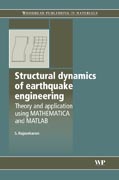
Structural dynamics of earthquake engineering: theory and application using Mathematica and Matlab
Rajasekaran, S.
Given the risk of earthquakes in many countries, knowing how structural dynamics can be applied to earthquake engineering of structures, both in theory andpractice, is a vital aspect of improving the safety of buildings and structures. It can also reduce the number of deaths and injuries and the amount of property damage. The book begins by discussing free vibration of single-degree-of-freedom (SDOF) systems, both damped and undamped, and forced vibration (harmonic force) of SDOF systems. Response to periodic dynamic loadings and impulse loads are also discussed, as are two degrees of freedom linear system responsemethods and free vibration of multiple degrees of freedom. Further chapters cover time history response by natural mode superposition, numerical solution methods for natural frequencies and mode shapes and differential quadrature, transformation and Finite Element methods for vibration problems. Other topics such as earthquake ground motion, response spectra and earthquake analysis of linear systems are discussed.Structural dynamics of earthquake engineering: theory and application using Mathematica and Matlab will provide civil and structural engineers and studentswith an understanding of the dynamic response of structures to earthquakes and the common analysis techniques employed to evaluate these responses. Worked examples in Mathematica and Matlab are given. ÍNDICE: Introduction to dynamics. Part 1 Structural dynamics in relation to earthquakes: Free vibration of single-degree-of-freedom (SDOF) systems (Undamped) in relation to structural dynamics during earthquakes; Free vibration ofsingle-degree-of-freedom systems (Damped) in relation to structural dynamics during earthquakes; Forced vibration (harmonic force) of single-degree-of-freedom systems in relation to structural dynamics during earthquakes; Response ofstructures to periodic dynamic loadings; Response of structures to impulse loads; Dynamic response of structures using numerical methods; Generalized coordinates and energy methods in relation to structural dynamics during earthquakes; Two degrees of freedom linear system response of structures; Free vibrationof multiple degrees of freedom in relation to structural dynamics during earthquakes; Numerical solution methods for natural frequencies and mode shapes inrelation to structural dynamics during earthquakes; Time history response by mode superposition in relation to structural dynamics during earthquakes; Freeand forced vibration of a continuous system in relation to structural dynamics during earthquakes; Finite element method in relation to structural dynamicsduring earthquakes; Differential quadrature and transformation methods for vibration problems in relation to structural dynamics during earthquakes. Part 2Response of structures to earthquakes: Earthquakes and earthquake ground motion; Earthquake response spectra; Earthquake analysis of linear systems; Building codes for a seismic design; Response of structures to earthquakes: approximate analysis techniques for lateral loads; Response of structures to earthquakes: analysis of shear walls
- ISBN: 978-1-84569-518-7
- Editorial: Woodhead
- Encuadernacion: Cartoné
- Páginas: 640
- Fecha Publicación: 01/04/2009
- Nº Volúmenes: 1
- Idioma: Inglés
